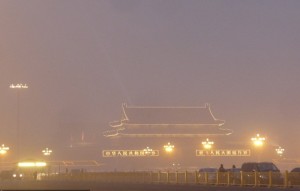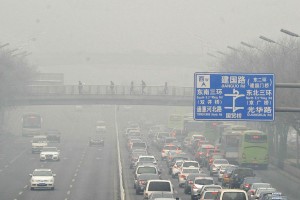Background
Beijing is the capital city of China with a population of more than 19.72 million. There are over 5 million private vehicles in Beijing and traffic congestion is very common in rush hours. Although the bus system (there are 62026 buses in Beijing) and subway system (16 subway lines) in Beijing are very busy, people still complain about the traffic jam. There are three major policies to reduce traffic congestion and I believe some of them are very useful. The three major policies are: cheap public transport system, odd-even license plate system and license quota system. These policies were introduced by Mayor Wang Qishan who is from the Communist Party of China, the ruling party in China. Because of the Beijing Olympic games in 2008, Beijing government decided to reduce traffic congestion and reward Beijing citizens.
The goals of these policies are the same: Reducing traffic volume in certain areas (from 1st Ring Road to 5th Ring Road), reducing carbon emission and encouraging residents to use public transport system.
Implementation
Cheap Public Transport System:
From Oct 7th, 2007, it was announced that bus ticket price is ¥0.4 for adults and ¥0.2 for students. The subway ticket price is ¥2 for all zones. In order to show how cheap the price is, I’d like to show some numbers. In 2011, real GDP per capita in Beijing is ¥80394. A Big Mac is ¥15 and a bottle of 2 litres coke is ¥6.5. In Vancouver, the price of a Big Mac is about $5 and a bottle of coke is about $2.5. That means, a bus ticket price for adults is just like $0.1 in Vancouver and a bus ticket for students is even less than $0.05. The ticket price of all zones subway is $0.67. We can see how cheap the ticket price is.
Odd-even License Plate System:
From August 17th, 2007, Beijing government announced that odd-even license plate system was implemented. You can drive freely on weekends and holidays but can’t drive your car within the 5th ring road, if:
On Monday, if tail number of license plate is 0 and 5;
On Tuesday, if tail number of license plate is 1 and 6;
On Wednesday, if tail number of license plate is 2 and 7;
On Thursday, if tail number of license plate is 3 and 8;
On Friday, if tail number of license plate is 4 and 9. [1]
License Quota System:
From Jan 1st, 2011, the license quota system was implemented and everyone who wants to buy a car in Beijing must register by the first eight days of every month and only 17,600 applicants can get the quota every month. The government uses computer to randomly choose the “lucky” applicants and there are 563,645 applicants every month. So, only 3% applicants can get the quota. If you get the quota but don’t buy a car within 6 months, the quota will expire.
Coverage
For odd-even license plate system, there are some vehicles that do not need to be covered in the policy. Police cars, ambulance, school bus, engineering rescue vehicles, gardening vehicles, taxis, buses, fire trucks, and law enforcement vehicles are not covered in the policy. For license quota system, only applicants who live in Beijing without cars can apply for the quota. 88% of the total quota was given to private buyers, 2% of the quota was given to bus system and 10% of the quota was given to private and public companies.
Distributional Impacts
Cheap public transport system is good for poor and middle class people. With the cheapest ticket price in China, people in Beijing like to travel by public transport if it is unnecessary to drive private cars. Rich people, however, don’t care about the low price of public transport because they like the convenience of driving cars. Odd-even license plate system is fair to everyone, no matter you are rich or not, if today your car is limited to drive, you are not allowed to drive. However, some people want to buy second cars so they can drive every day. Of course this is not a common issue, however, if rich people buy second cars, there will be more cars in Beijing and the traffic congestion will increase. So, the policy of license quota system was introduced to solve the problem. With the quota, every applicant has the same opportunity to buy a car. Since the quota is randomly distributed and only people without cars can get the quota, rich people can’t get the “privilege” of owning two cars.
Cost-Effectiveness
In order to keep Cheap Public Transport System, the net cost of Beijing government is ¥13.8 billion [2].(about 2.23 billion CAD) every year. Compare with other cities, the low price policy benefits at least 80% citizens in Beijing and it is a good way to reduce traffic congestion because people can use the convenient public transport system almost freely. However, some people argued that it can be more cost-efficient if the money paid to the public transport system can be used to benefit specific groups. For example, the money can be used to support poor students and patients. However, as a policy to benefit everyone and reduce traffic volume, Cheap Public Transport System policy is successful. Beijing government did a survey to see if it is possible to increase the ticket price a little and most people said they will still use public transport system even the price is higher. Odd-even license plate system is a direct way to reduce traffic congestion. Although it can make some people feel inconvenient in one day of a week, it is still a good policy. People can use public transport and there will be about 1 million cars have to “rest”. It is very helpful to reduce the traffic jam when 1 million drivers are not allowed to drive every day. License quota system is also a direct way to reduce traffic jams. In 2011, about 617,000 applicants can’t buy cars because they don’t have the quota. [3] This is very impressive and it is believed this policy can cause a loss of ¥100 billion (about $16.13 billion) to local dealers, automakers and government revenue. However, Beijing government insists the policy because it is a good way to reduce vehicle increasing. It is the price of reducing traffic congestion.
Conclusion
There are three major policies in Beijing to reduce traffic jam: cheap public transport system, odd-even license plate system and license quota system. Cheap public transport system can benefit everyone in Beijing and it is like a tax return to everyone. Odd-even license plate system is a good way to reduce 20% cars on the road with zero cost. The cost effectiveness is very good. License quota system is very expensive because the quota will reduce vehicle consumptions.
Reference
[1]. The official website of Beijing Traffic Management Office: http://www.bjjtgl.gov.cn/zhuanti/10weihao/index.html
[2]. In 2012, the government subsidy for Beijing public transport system is ¥13.82 billion: http://auto.163.com/13/0126/19/8M5SUKBQ00084IK8.html
[3]. The official website of vehicle quota management Office: http://www.bjhjyd.gov.cn/









